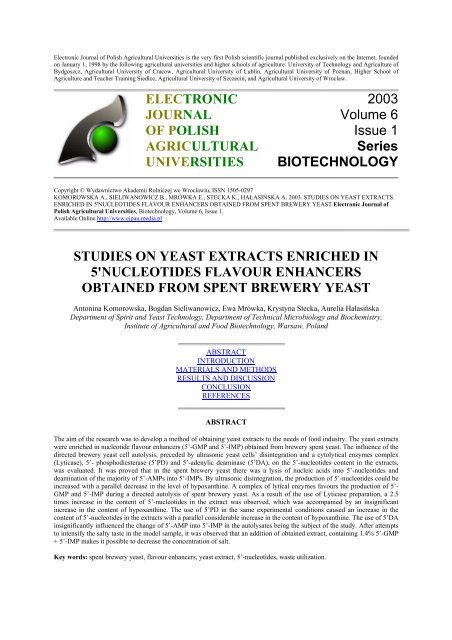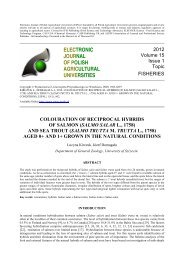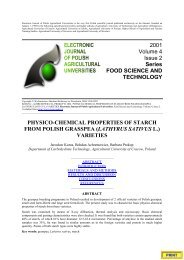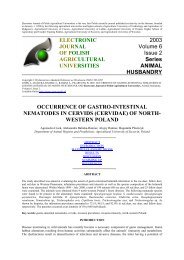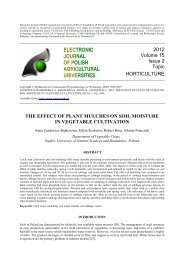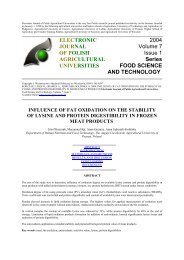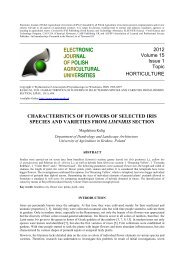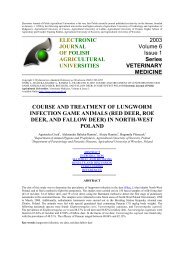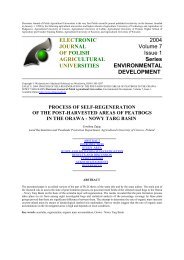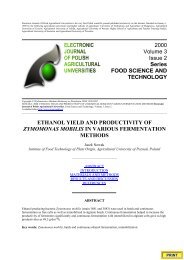studies on yeast extracts enriched in 5'nucleotides flavour ...
studies on yeast extracts enriched in 5'nucleotides flavour ...
studies on yeast extracts enriched in 5'nucleotides flavour ...
Create successful ePaper yourself
Turn your PDF publications into a flip-book with our unique Google optimized e-Paper software.
Electr<strong>on</strong>ic Journal of Polish Agricultural Universities is the very first Polish scientific journal published exclusively <strong>on</strong> the Internet, founded<strong>on</strong> January 1, 1998 by the follow<strong>in</strong>g agricultural universities and higher schools of agriculture: University of Technology and Agriculture ofBydgoszcz, Agricultural University of Cracow, Agricultural University of Lubl<strong>in</strong>, Agricultural University of Poznan, Higher School ofAgriculture and Teacher Tra<strong>in</strong><strong>in</strong>g Siedlce, Agricultural University of Szczec<strong>in</strong>, and Agricultural University of Wroclaw.ELECTRONICJOURNALOF POLISHAGRICULTURALUNIVERSITIES2003Volume 6Issue 1SeriesBIOTECHNOLOGYCopyright © Wydawnictwo Akademii Rolniczej we Wroclawiu, ISSN 1505-0297KOMOROWSKA A., SIELIWANOWICZ B., MRÓWKA E., STECKA K., HAŁASIŃSKA A. 2003. STUDIES ON YEAST EXTRACTSENRICHED IN 5'NUCLEOTIDES FLAVOUR ENHANCERS OBTAINED FROM SPENT BREWERY YEAST Electr<strong>on</strong>ic Journal ofPolish Agricultural Universities, Biotechnology, Volume 6, Issue 1.Available Onl<strong>in</strong>e http://www.ejpau.media.plSTUDIES ON YEAST EXTRACTS ENRICHED IN5'NUCLEOTIDES FLAVOUR ENHANCERSOBTAINED FROM SPENT BREWERY YEASTAnt<strong>on</strong><strong>in</strong>a Komorowska, Bogdan Sieliwanowicz, Ewa Mrówka, Krystyna Stecka, Aurelia HałasińskaDepartment of Spirit and Yeast Technology, Department of Technical Microbiology and Biochemistry,Institute of Agricultural and Food Biotechnology, Warsaw, PolandABSTRACTINTRODUCTIONMATERIALS AND METHODSRESULTS AND DISCUSSIONCONCLUSIONREFERENCESABSTRACTThe aim of the research was to develop a method of obta<strong>in</strong><strong>in</strong>g <strong>yeast</strong> <strong>extracts</strong> to the needs of food <strong>in</strong>dustry. The <strong>yeast</strong> <strong>extracts</strong>were <strong>enriched</strong> <strong>in</strong> nucleotide <strong>flavour</strong> enhancers (5’-GMP and 5’-IMP) obta<strong>in</strong>ed from brewery spent <strong>yeast</strong>. The <strong>in</strong>fluence of thedirected brewery <strong>yeast</strong> cell autolysis, preceded by ultras<strong>on</strong>ic <strong>yeast</strong> cells’ dis<strong>in</strong>tegrati<strong>on</strong> and a cytolytical enzymes complex(Lyticase), 5’- phosphodiesterase (5’PD) and 5’-adenylic deam<strong>in</strong>ase (5’DA), <strong>on</strong> the 5’-nucleotides c<strong>on</strong>tent <strong>in</strong> the <strong>extracts</strong>,was evaluated. It was proved that <strong>in</strong> the spent brewery <strong>yeast</strong> there was a lysis of nucleic acids <strong>in</strong>to 5’-nucleotides anddeam<strong>in</strong>ati<strong>on</strong> of the majority of 5’-AMPs <strong>in</strong>to 5’-IMPs. By ultras<strong>on</strong>ic dis<strong>in</strong>tegrati<strong>on</strong>, the producti<strong>on</strong> of 5’-nucleotides could be<strong>in</strong>creased with a parallel decrease <strong>in</strong> the level of hypoxanth<strong>in</strong>e. A complex of lytical enzymes favours the producti<strong>on</strong> of 5’-GMP and 5’-IMP dur<strong>in</strong>g a directed autolysis of spent brewery <strong>yeast</strong>. As a result of the use of Lyticase preparati<strong>on</strong>, a 2.5times <strong>in</strong>crease <strong>in</strong> the c<strong>on</strong>tent of 5’-nucleotides <strong>in</strong> the extract was observed, which was accompanied by an <strong>in</strong>significant<strong>in</strong>crease <strong>in</strong> the c<strong>on</strong>tent of hypoxanth<strong>in</strong>e. The use of 5’PD <strong>in</strong> the same experimental c<strong>on</strong>diti<strong>on</strong>s caused an <strong>in</strong>crease <strong>in</strong> thec<strong>on</strong>tent of 5’-nucleotides <strong>in</strong> the <strong>extracts</strong> with a parallel c<strong>on</strong>siderable <strong>in</strong>crease <strong>in</strong> the c<strong>on</strong>tent of hypoxanth<strong>in</strong>e. The use of 5’DA<strong>in</strong>significantly <strong>in</strong>fluenced the change of 5’-AMP <strong>in</strong>to 5’-IMP <strong>in</strong> the autolysates be<strong>in</strong>g the subject of the study. After attemptsto <strong>in</strong>tensify the salty taste <strong>in</strong> the model sample, it was observed that an additi<strong>on</strong> of obta<strong>in</strong>ed extract, c<strong>on</strong>ta<strong>in</strong><strong>in</strong>g 1.4% 5’-GMP+ 5’-IMP makes it possible to decrease the c<strong>on</strong>centrati<strong>on</strong> of salt.Key words: spent brewery <strong>yeast</strong>, <strong>flavour</strong> enhancers, <strong>yeast</strong> extract, 5’-nucleotides, waste utilizati<strong>on</strong>.
INTRODUCTIONA group of chemical compounds act<strong>in</strong>g as “improvers” of taste features are comm<strong>on</strong>ly called <strong>flavour</strong> enhancers.These compounds hav<strong>in</strong>g no significant taste, or hav<strong>in</strong>g no taste at all, <strong>in</strong>crease the taste sensati<strong>on</strong> of othersubstances, by modify<strong>in</strong>g or dim<strong>in</strong>ish<strong>in</strong>g its <strong>in</strong>tensity or by mystify<strong>in</strong>g any redundant tastes.The noti<strong>on</strong> of <strong>flavour</strong> enhancers is reserved to a group of over a dozen of compounds: glutamic acid, guanylicacid and <strong>in</strong>ozylic acid and their salts [2,10,11,18]. Flavour enhancers have been drawn <strong>on</strong> the GRAS list and areapproved by FDA to be the safe food additives not requir<strong>in</strong>g a daily ADI dose. At present 5’-nucleotides togetherwith <strong>yeast</strong> <strong>extracts</strong> are basic additives <strong>in</strong> ready-made food, which is easy to prepare [12,14,16,17]. The two<strong>in</strong>tensifiers mostly used <strong>in</strong> food producti<strong>on</strong>, i.e. disodium 5’-<strong>in</strong>ozynate and disodium 5’-guanylate <strong>in</strong>comb<strong>in</strong>ati<strong>on</strong> with m<strong>on</strong>osodium glutamate (MSG), develop the “umami” taste – acknowledged especially <strong>in</strong> Asiato be the fifth basic taste [3]. Yeast, featur<strong>in</strong>g high nucleic acids’c<strong>on</strong>tent, atta<strong>in</strong><strong>in</strong>g even over 10% RNA <strong>in</strong> theirdry mass substance, could be the source of obta<strong>in</strong><strong>in</strong>g 5’-nucleotides: 5’-GMP and 5’-IMP [10]. After the processof autolysis and a partial hydrolysis of nucleic acids with the use of different methods, am<strong>on</strong>g the mostfrequently used enzymatic method with 5’-phosphodiesterase (5’FD), 5’-nucleotides are extracted from the <strong>yeast</strong>biomass or left <strong>in</strong> the extract, which results <strong>in</strong> obta<strong>in</strong><strong>in</strong>g an <strong>enriched</strong> extract. A hypothesis imply<strong>in</strong>g thatm<strong>on</strong>osodium glutamate (MSG) <strong>in</strong> a jo<strong>in</strong>t form (e.g. with prote<strong>in</strong>) does not cause allergies, <strong>in</strong>fluenced an <strong>in</strong>crease<strong>in</strong> popularity of these <strong>extracts</strong> used as taste and scent enhancers <strong>in</strong> food technology. The demand of this k<strong>in</strong>dtriggered the producti<strong>on</strong> of <strong>yeast</strong> <strong>extracts</strong> <strong>enriched</strong> <strong>in</strong> 5’-IMP and 5’-GMP [4].One of the elements of complex use of spent <strong>yeast</strong> <strong>in</strong> the brewery, would be the way of them be<strong>in</strong>g the source ofobta<strong>in</strong><strong>in</strong>g <strong>extracts</strong> <strong>enriched</strong> <strong>in</strong> <strong>flavour</strong> enhancers [8].This would make the possibility of m<strong>in</strong>imaliz<strong>in</strong>g the c<strong>on</strong>tam<strong>in</strong>ati<strong>on</strong> by sewage, which regards the envir<strong>on</strong>mentprotecti<strong>on</strong> requirements, feasible [5,7,13]. Another argument speak<strong>in</strong>g <strong>in</strong> favour of tak<strong>in</strong>g acti<strong>on</strong> <strong>in</strong> this doma<strong>in</strong>of life is the c<strong>on</strong>sumer fearfulness l<strong>in</strong>ked to the allergic reacti<strong>on</strong> caused by MSG be<strong>in</strong>g added to a number ofmeals also <strong>in</strong> Poland [9,10,19]. The direct aim of the research was to obta<strong>in</strong> the maximum level of nucleic acids’degradati<strong>on</strong> <strong>in</strong>to 5’-nucleotides <strong>in</strong> the spent brewery <strong>yeast</strong> <strong>extracts</strong>.MaterialsMATERIALS AND METHODSThe research material was postproductive, waste brewer’s <strong>yeast</strong>s, the producti<strong>on</strong> stra<strong>in</strong>, bel<strong>on</strong>ged to WeihenStephan Collecti<strong>on</strong>, no 4/79 (Browary Królewskie SA, Warszawa). The gist part of spent brewery <strong>yeast</strong>s wasdebittered with the use of a method developed exclusively for the sake of the research [15].Quantitative determ<strong>in</strong>ati<strong>on</strong> of 5’nucleotidesThe 5’-nucleotides c<strong>on</strong>tent and the hypoxanth<strong>in</strong>e c<strong>on</strong>tent was determ<strong>in</strong>ed by us<strong>in</strong>g of HPLC (Waters, columnmi-B<strong>on</strong>dpak C18, detecti<strong>on</strong> UV 254 nm) with the use of external standards of 5’-nucleotides and hypoxanth<strong>in</strong>e(Sigma).Autolysis of brewery <strong>yeast</strong>sOptimal c<strong>on</strong>diti<strong>on</strong>s of releas<strong>in</strong>g the cytoplasmatic gist from <strong>yeast</strong> cells dur<strong>in</strong>g the process of autolysis werechosen <strong>on</strong> the basis of a former research [6]. after preced<strong>in</strong>g ultras<strong>on</strong>ic dis<strong>in</strong>tegrati<strong>on</strong> (by S<strong>on</strong>ics VC-601, S<strong>on</strong>icsand Materials Inc., Vibra Cells TM) with the applicati<strong>on</strong> of a 13 mm tip <strong>in</strong> chosen c<strong>on</strong>diti<strong>on</strong>s.The process of autolysis of debittered <strong>yeast</strong> suspensi<strong>on</strong> (10% dry mass) was c<strong>on</strong>ducted <strong>in</strong> the presence of adipicacid (0.5% w/w by Sigma) act<strong>in</strong>g as the <strong>in</strong>ductor of autolysis <strong>in</strong> the laboratory shaker (New Bruswick ScientificCo, USA) (c<strong>on</strong>diti<strong>on</strong>s: 50°C; 24 h) An optimal character of the c<strong>on</strong>diti<strong>on</strong>s of autolysis was chosen.Enzymatic hydrolysisBoth the <strong>yeast</strong> cell walls (enzyme complex: Lyticase Rhizoct<strong>on</strong>ia solani, ICN Biomedical Inc.) and the <strong>yeast</strong>sRNA were exposed to the <strong>in</strong>fluence of hydrolytic enzymes, with the applicati<strong>on</strong> of 5’-phosphodiesterase(Arthrobacter luteus, INC Biomedical Inc.) (5’FD), and <strong>in</strong> the aim of bioc<strong>on</strong>versi<strong>on</strong> of 5’ -AMP <strong>in</strong>to 5’-IMP by5’-adenylic deam<strong>in</strong>ase (5’DA) (Sigma).The hydrolysis was c<strong>on</strong>ducted dur<strong>in</strong>g periods of the different time;subsequently the <strong>yeast</strong> suspensi<strong>on</strong> was autolysed (pH 4.5) <strong>in</strong> the previously stated c<strong>on</strong>diti<strong>on</strong>s.
A dose of 5’-phosphodiesterase was selected for obta<strong>in</strong><strong>in</strong>g the maximum 5’-nucleotides c<strong>on</strong>tent <strong>in</strong> the <strong>extracts</strong>that were previously exposed to ultras<strong>on</strong>ic dis<strong>in</strong>tegrati<strong>on</strong>. 5’PD was added to suspensi<strong>on</strong> of debittered brewery<strong>yeast</strong>, then <strong>in</strong>cubated for 4 hours <strong>in</strong> 37°C, pH 7.5. In order to <strong>in</strong>crease the amount of brewery <strong>yeast</strong> cellscytoplasmatic compounds released, a complex of cytolytical enzymes (Lyticase) c<strong>on</strong>ta<strong>in</strong><strong>in</strong>g beta-1,3-glucanase,protease, hemicelulase, pect<strong>in</strong>ase and amylase was used. 8, 16 and 32 mg/g (4h, 25°C) doses of the enzyme wereused, followed by an autolysis c<strong>on</strong>ducted <strong>in</strong> previously established c<strong>on</strong>diti<strong>on</strong>s. Two series of experiments werecarried out, each made <strong>in</strong> triplicate.Preparati<strong>on</strong> the <strong>yeast</strong> extract <strong>enriched</strong> <strong>in</strong> 5’nucleotidesTo c<strong>on</strong>duct both a prelim<strong>in</strong>ary evaluati<strong>on</strong> of the applicability of obta<strong>in</strong>ed <strong>extracts</strong> <strong>enriched</strong> <strong>in</strong> 5’nucleotides astaste enhancers and a general evaluati<strong>on</strong> of the efficiency of the process, a majority part of the suspensi<strong>on</strong> be<strong>in</strong>gthe subject- matter was obta<strong>in</strong>ed <strong>in</strong> the previously stated c<strong>on</strong>diti<strong>on</strong>s. An <strong>in</strong>ductor was added to a 10% suspensi<strong>on</strong>of debittered brewery <strong>yeast</strong> <strong>in</strong> the volume of 3 kg and pH adjusted to 4.5, which was followed by a 24-hourautolysis <strong>in</strong> 50°C.The autolysis was preceded by a 1-m<strong>in</strong>ute ultras<strong>on</strong>ic dis<strong>in</strong>tegrati<strong>on</strong>. Subsequently the suspensi<strong>on</strong> was exposed tothe Lyticase enzyme <strong>in</strong> the amount of 150 mg/kg for 4 hours. After aforesaid treatment, with the use of acentrifug<strong>in</strong>g mach<strong>in</strong>e (9000 sp<strong>in</strong>s/m<strong>in</strong>ute), the extract obta<strong>in</strong>ed by extract<strong>in</strong>g if from the cell walls subsequentlydried (90°C/120°C).Sensory evaluati<strong>on</strong>Sensory evaluati<strong>on</strong> was c<strong>on</strong>ducted <strong>in</strong> accordance with a PN ISO 3972 norm [1] for an 8-member group. Thethreshold of detectability and recognizability of salty taste and of the extract was evaluated. After determ<strong>in</strong><strong>in</strong>gthe c<strong>on</strong>centrati<strong>on</strong> of extract below the threshold of detectability, an attempt to <strong>in</strong>tensify the salty taste wasc<strong>on</strong>ducted. The basic soluti<strong>on</strong> applied to sensory evaluati<strong>on</strong> was a 0.2% soluti<strong>on</strong> of brewery spent <strong>yeast</strong> extractc<strong>on</strong>ta<strong>in</strong><strong>in</strong>g 1.4% of 5’-GMP and 5’-IMP.The reacti<strong>on</strong> of the release of nucleotides 5’-GMP and 5’-IMP as a result of a c<strong>on</strong>trolled autolysis of <strong>yeast</strong> cells,assisted by the activity of egzogenic hydrolytic enzymes and ultras<strong>on</strong>ic dis<strong>in</strong>tegrati<strong>on</strong> was be<strong>in</strong>g studied.Subsequently adipic acid was added, act<strong>in</strong>g as an <strong>in</strong>ductor of autolysis, and pH adjusted to 4.5, the suspensi<strong>on</strong>be<strong>in</strong>g subsequently exposed to autolysis (50°C, 24h).RESULTS AND DISCUSSIONThe aim of the research was to obta<strong>in</strong> the highest degradati<strong>on</strong> of nucleic acids to 5’-nucleotides <strong>in</strong> obta<strong>in</strong>ed<strong>extracts</strong> of spent brewery <strong>yeast</strong>s. Dis<strong>in</strong>tegrati<strong>on</strong> of <strong>yeast</strong> cells was c<strong>on</strong>ducted with the use of ultrasounds,autolysis <strong>in</strong> chosen c<strong>on</strong>diti<strong>on</strong>s and enzymatic hydrolysis, with the use of a complex of enzymes lys<strong>in</strong>g the <strong>yeast</strong>cell wall. Spent brewery <strong>yeast</strong> orig<strong>in</strong>at<strong>in</strong>g from the Browar Warszawski brewery was chosen to the needs of theresearch. The <strong>in</strong>fluence of the time of ultras<strong>on</strong>ic dis<strong>in</strong>tegrati<strong>on</strong> of debittered brewery <strong>yeast</strong> <strong>on</strong> the 5’-nucleotidesc<strong>on</strong>tent <strong>in</strong> the obta<strong>in</strong>ed <strong>extracts</strong> was evaluated. Optimal ultras<strong>on</strong>ic dis<strong>in</strong>tegrati<strong>on</strong> c<strong>on</strong>diti<strong>on</strong>s were established: thedurati<strong>on</strong> of impulses and the percentage of power of the apparatus used <strong>in</strong> the research. A 3-sec<strong>on</strong>d impulse anda 90% power of the apparatus were established as the best c<strong>on</strong>diti<strong>on</strong>s. 1 m<strong>in</strong>ute was established to be the optimaltime of dis<strong>in</strong>tegrati<strong>on</strong>.The level of release of 5’-nucleotides and hypoxanth<strong>in</strong>e was then measured, where pH parameter of theautolys<strong>in</strong>g suspensi<strong>on</strong> of 10%dry mass brewery <strong>yeast</strong> was be<strong>in</strong>g established (table 1).pH 4.5 was determ<strong>in</strong>ed to the most beneficial c<strong>on</strong>diti<strong>on</strong>.The extend to which alkal<strong>in</strong>e hydrolysis, with the use of 0.3M KOH <strong>in</strong>fluences the <strong>in</strong>crease of 5’nucleotidesc<strong>on</strong>tent <strong>in</strong> the extract was evaluated. Hydrolysis was c<strong>on</strong>ducted after the process of autolysis had f<strong>in</strong>ished.Alkal<strong>in</strong>e hydrolysis of brewery <strong>yeast</strong> extract didn’t <strong>in</strong>crease the 5’-nucleotides c<strong>on</strong>tent <strong>in</strong> the extract.
Table 1. The <strong>in</strong>fluence of pH of the autolysis <strong>on</strong> the process of 5’-nucleotides release from brewery<strong>yeast</strong>pH ofC<strong>on</strong>tent of (mg/g dry mass)autolysis AMP GMP+IMP UMP CMP hypoxanth<strong>in</strong>e3.54.04.55.05.50.765.026.377.7913.944.5511.9314.1011.6313.280.550.580.463.020.430.001.021.482.361.650.222.873.503.733.77Optimal c<strong>on</strong>diti<strong>on</strong>s of 5’nucleotides release with the use of 5’-phoshodiesterase (5’FD) was evaluated (table 2).Preparati<strong>on</strong>s was made from another part of the material - spent brewery <strong>yeast</strong>.The additi<strong>on</strong> of 5’-phosphodiesterase to all applied doses was not c<strong>on</strong>siderably <strong>in</strong>fluenc<strong>in</strong>g the 5’-GMP and 5’-IMP levels <strong>in</strong> <strong>extracts</strong> obta<strong>in</strong>ed for <strong>on</strong>e pH value, nor it was chang<strong>in</strong>g the hypoxanth<strong>in</strong>e c<strong>on</strong>tent.Table 2. The <strong>in</strong>fluence of hydrolysis c<strong>on</strong>ducted with the use of 5’-phosphodiesterase and the autolysis <strong>on</strong> the release of5’nucleotides from brewery <strong>yeast</strong>s (37°C)pHEnzymec<strong>on</strong>centrati<strong>on</strong>C<strong>on</strong>tent of(mg/g dry mass)[j /g dry mass] AMP GMP+IMP UMP CMP hypoxanth<strong>in</strong>e4.5 00.30.61.50.000.040.000.568.408.878.709.082.021.430.721.840.002.351.050.004.035.755.920.72The <strong>in</strong>fluence of the time of hydrolysis and the dose of 5’-adenylic deam<strong>in</strong>ase <strong>on</strong> the level of 5’- nucleotides wasc<strong>on</strong>ducted. With a dose of 0.45 units of enzyme, after a 50 m<strong>in</strong>utes of hydrolysis, an <strong>in</strong>crease <strong>in</strong> the c<strong>on</strong>tent of5’-GMP + 5’-IMP <strong>in</strong> the extract was observed with a parallel <strong>in</strong>crease <strong>in</strong> the c<strong>on</strong>tent of hypoxanth<strong>in</strong>e. At a doseof a 1.35 units of enzyme after a 60-m<strong>in</strong>utes-l<strong>on</strong>g hydrolysis a double <strong>in</strong>crease <strong>in</strong> 5’-GMP and 5’-IMP c<strong>on</strong>tentwas observed with a parallel almost quadruple <strong>in</strong>crease <strong>in</strong> the c<strong>on</strong>tent of hypoxanth<strong>in</strong>e.A hydrolysis of brewery <strong>yeast</strong> dry mass with a use of cytolytical enzymes complex (Lyticase) was c<strong>on</strong>ducted(table 3).Table 3. The <strong>in</strong>fluence of cell wall hydrolysis with the use of a enzyme Lyticase and a subsequent autolysis<strong>on</strong> the 5’-nucleotides c<strong>on</strong>tent <strong>in</strong> a spent brewery <strong>yeast</strong> extract durati<strong>on</strong> of enzyme treatmentThe amount ofenzyme/g dry massof <strong>yeast</strong>[mg]081632C<strong>on</strong>tent of (mg/g dry mass)AMP GMP+IMP hypoxanth<strong>in</strong>e0.701.651.920.981.302.183.351.220.991.311.151.18The additi<strong>on</strong> of a lytic enzyme <strong>in</strong> the c<strong>on</strong>centrati<strong>on</strong> of 16 mg/g <strong>in</strong>creased the c<strong>on</strong>tentof 5’-nucleotides <strong>in</strong> the post-productive brewery <strong>yeast</strong> extract more than two times, with a parallel slight <strong>in</strong>crease<strong>in</strong> the c<strong>on</strong>tent of hypoxanth<strong>in</strong>e.The sensory analysis was c<strong>on</strong>ducted <strong>in</strong> a team of 8 people. For 6 members of the team the threshold of saltc<strong>on</strong>centrati<strong>on</strong> detectability was established at 0.48 g/l (dissoluti<strong>on</strong> D5), for the rema<strong>in</strong><strong>in</strong>g - 2, at 0.69 g/l (D4).After the evaluati<strong>on</strong> of the salty taste detectability threshold, it was observed that it appears at 0.69 g/l saltc<strong>on</strong>centrati<strong>on</strong> (4 assessors) and at 0.98 g/l (4 assessors), (which corresp<strong>on</strong>ds with a statistic threshold of saltytaste detectability). Subsequently the “umami” taste threshold detectability was evaluated, for the soluti<strong>on</strong>s of aspent brewery <strong>yeast</strong>’s extract <strong>in</strong> the c<strong>on</strong>centrati<strong>on</strong> from 0.08 to 1g/l. 5 members of the sensory team found the0.12 g/l (D6) c<strong>on</strong>centrati<strong>on</strong> to be the threshold of detectability, 1 member the 0.17 g/l c<strong>on</strong>centrati<strong>on</strong> and 1member the 0.08 c<strong>on</strong>centrati<strong>on</strong>.
It was established that for the evaluati<strong>on</strong> of taste <strong>in</strong>tensificati<strong>on</strong> (i.e. lower<strong>in</strong>g of the salty taste detectabilitythreshold), a c<strong>on</strong>centrati<strong>on</strong> of 0.08 g/l shall be optimal, be<strong>in</strong>g lower than the threshold of detectability at the levelof which a different taste is not <strong>in</strong>troduced. Series of salt soluti<strong>on</strong>s were prepared, with the first experiment,where the preparati<strong>on</strong> c<strong>on</strong>centrati<strong>on</strong> levels were 0.08 g/l. After the experiment it was stated that 5 of 8 membersof the sensory team determ<strong>in</strong>ed the detectability threshold at the c<strong>on</strong>centrati<strong>on</strong> of 0.24 g/l (dissoluti<strong>on</strong> D7), whilethe salty taste detectability threshold was established for the dissoluti<strong>on</strong>s D5 and D4.Applicati<strong>on</strong> of obta<strong>in</strong>ed preparati<strong>on</strong>s to the evaluati<strong>on</strong> of their usefulness <strong>in</strong> a particular food product requiresfurther research.CONCLUSIONSpent brewery <strong>yeast</strong> may c<strong>on</strong>stitute a material for obta<strong>in</strong><strong>in</strong>g <strong>yeast</strong> <strong>extracts</strong> <strong>enriched</strong> with 5’-nucleotides. As aresult of <strong>in</strong>duced autolysis (24 h at 50°C) <strong>in</strong> adjusted c<strong>on</strong>diti<strong>on</strong>s pH (4.5) with the participati<strong>on</strong> of autolysis<strong>in</strong>ductor of (0.5% adypic acid), there was a c<strong>on</strong>siderable dis<strong>in</strong>tegrati<strong>on</strong> of nucleic acids towards 5’-nucleotidesand a deam<strong>in</strong>ati<strong>on</strong> of the majority of 5’-AMP to 5’-IMP. By the hydrolysis with the use of cell wall lyticenzymes complex (Lyticase), and directed autolysis of spent brewery <strong>yeast</strong>, there was even a 2.5 times <strong>in</strong>crease<strong>in</strong> the 5'-nucleotides c<strong>on</strong>tent <strong>in</strong> the extract observed, with a parallel slight <strong>in</strong>crease of hypoxanth<strong>in</strong>e c<strong>on</strong>tent. Inthe same experimental c<strong>on</strong>diti<strong>on</strong>s, applicati<strong>on</strong> of 5’-phosphodiesterase and 5’-adenylic deam<strong>in</strong>ase caused a slight<strong>in</strong>crease <strong>in</strong> the process of 5’-nucleotides release with a parallel <strong>in</strong>crease <strong>in</strong> the c<strong>on</strong>tent of hypoxanth<strong>in</strong>e. Similarly<strong>in</strong>corporat<strong>in</strong>g the enzymes of liv<strong>in</strong>g <strong>yeast</strong> <strong>in</strong>to the process of hydrolysis of nucleic acids <strong>in</strong>to autolysis of spentbrewery <strong>yeast</strong> did not cause an <strong>in</strong>crease of 5’-GMP+5’-IMP c<strong>on</strong>tent <strong>in</strong> the autolysate.Us<strong>in</strong>g optimal ultras<strong>on</strong>ic dis<strong>in</strong>tegrati<strong>on</strong> parameters it is possible to <strong>in</strong>crease the c<strong>on</strong>centrati<strong>on</strong> of the 5’-nucleotides release, parallel to a decrease <strong>in</strong> the level of hypoxanth<strong>in</strong>e.After the essays to <strong>in</strong>tensity the salty taste with the use of obta<strong>in</strong>ed extract (c<strong>on</strong>ta<strong>in</strong><strong>in</strong>g 1.4% 5’-GMP+5’-IMP) itwas observed that an additive of this k<strong>in</strong>d makes a double dim<strong>in</strong>uti<strong>on</strong> of salt arrangement feasible.REFERENCES1. Analiza sensoryczna. Metodologia. Metoda sprawdzania wrażliwości smakowej, [Sensory analysis. Method of tastesensitivity test<strong>in</strong>g.] PN-ISO 3972, styczeń 1998 - Polski Komitet Normalizacyjny [<strong>in</strong> Polish].2. Baryłko-Pikielna N., 1975. Zarys Analizy Sensorycznej Żywności, [Profil of food sensory analysis.] WNTWarszawa, 157-160 [<strong>in</strong> Polish].3. C<strong>on</strong>n H., 1992. Umami, the fifth basic taste, Nutr. and Food Sci. 2: 21-23.4. Dill<strong>on</strong> M., 1993. Invasi<strong>on</strong> of the MSG-free <strong>in</strong>gredients, Food Eng. 65(4): 133-134.5. Kądzielski F., 1997. Ochr<strong>on</strong>a środowiska i redukcja odpadów w słodowni i browarze, [Envir<strong>on</strong>ment preventi<strong>on</strong> ofwaste materials <strong>in</strong> malt-house and brewery.] Przem.Ferm.Owoc-Warz. 41(9): 12-15. [<strong>in</strong> Polish]6. Komorowska A., Mrówka E., Stecka K., Grzybowski R., 1998. Badania nad wpływem wybranych <strong>in</strong>duktorów naefektywność autolizy drożdży piekarskich, [Studies of selected <strong>in</strong>ductors to efectivity of autolysis of baker’s <strong>yeast</strong>.]Pr. Inst. Lab. Bad. Przem. Spoż. 53: 22-31 [<strong>in</strong> Polish].7. Kumider J., 1996. Utylizacja odpadów przemysłu rolno-spożywczego. Aspekty towaroznawcze i ekologiczne,[Utilizati<strong>on</strong> of waste material of food and agriculture <strong>in</strong>dustry.] Wyd. Akad. Ek<strong>on</strong>om. w Poznaniu, Poznań, p. 88-89 [<strong>in</strong> Polish].8. Mermelste<strong>in</strong> N.H., 1981. C<strong>on</strong>t<strong>in</strong>uous fermentor produces natural flavor enhancers for foods and pet foods, FoodTechnol, 43(7): 50-53.9. Moriselli P., Garanth<strong>in</strong>i S., 1970. M<strong>on</strong>osodium glutamate and Ch<strong>in</strong>ese restaurant syndrome, Nature (L<strong>on</strong>d<strong>on</strong>) 227:611-612.10. Nagodawithana T., 1995. Savory Flavors, Esteckay Associates, Inc. Milwaukee, U.S.A. p.8-13, 76-83, 297-333.11. Nagodawithana T., 1992. Flavor enhancers: Their probable mode of acti<strong>on</strong>, Food Technol., 48:49-85.12. Nucleotides with the Ajnomoto Touch, Ajitide – Aj<strong>in</strong>omoto Co.,Inc, Japan.13. Ochr<strong>on</strong>a środowiska w przemyśle spożywczym. Przewodnik ogólny, [Envir<strong>on</strong>ment protecti<strong>on</strong> <strong>in</strong> food <strong>in</strong>dustry.General guide.] FAPA, Warszawa, 1988, 375 [<strong>in</strong> Polish].14. Provesta Co, 1993. Yeast <strong>in</strong>gredients helps ma<strong>in</strong>ta<strong>in</strong> chili flavor and texture, Prepared Food, 162(6): 61-63.15. Projekt badawczy KBN nr 5 P06G 014 18, E. Mrówka: “Badanie nad poprawą cech smakowych preparatówbiałkowych z drożdży piwowarskich, [Project by Research Gr<strong>on</strong>t State Committe for Scientific Research nr 5P06G 014 18, Improvement of organoleptic properties of prote<strong>in</strong> c<strong>on</strong>centrates from brewery <strong>yeast</strong>.] W-wa 2000 [<strong>in</strong>Polish].16. Ribotide®. Applicati<strong>on</strong>s, Prototype formulati<strong>on</strong> from the Test Kitchens of Takeda, Takeda Chemicals IndustriesLtd., Japan, p.1-31.17. Ribotide®. Always <strong>in</strong> good taste – Takeda Chemical Industries Ltd., Japan, p.1-16.18. Rutkowski A., Gwiazda S., Dąbrowski K., 1997. Substancje dodatkowe i składniki funkcj<strong>on</strong>alne Żywności, [Foodadditives and functi<strong>on</strong>al substances,] Agro Food Technology, Katowice, 178-185 [<strong>in</strong> Polish].19. Raiten D.,Talbot J., Fischer K.,1995. M<strong>on</strong>osodium glutamate, Food Technol. 49(10): 28.
This work was supported by the Research Grant State Committee for Scientific Research 5 P06G 016 17A. Komorowska, B. Sieliwanowicz, E. Mrówka, K. Stecka, A. HałasińskaInstitute of Agricultural and Food BiotechnologyDepartment of Technical Microbiology and Biochemistry,Department of Spirit and Yeast TechnologyRakowiecka 36, 02-532 Warsaw, Polande-mail: komorowska@ibprs.plResp<strong>on</strong>ses to this article, comments are <strong>in</strong>vited and should be submitted with<strong>in</strong> three m<strong>on</strong>ths of thepublicati<strong>on</strong> of the article. If accepted for publicati<strong>on</strong>, they will be published <strong>in</strong> the chapter headed‘Discussi<strong>on</strong>s’ <strong>in</strong> each series and hyperl<strong>in</strong>ked to the article.[BACK] [MAIN] [HOW TO SUBMIT] [SUBSCRIPTION] [ISSUES] [SEARCH]


